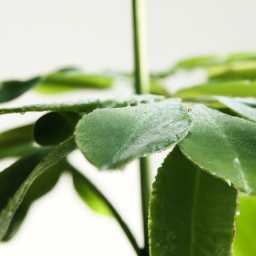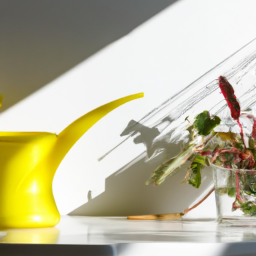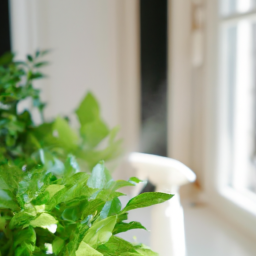
Have you ever wondered, “Should I mist indoor plants?” Many plant owners debate whether misting their indoor plants is necessary for their health and growth. Some believe that misting can help increase humidity levels, while others argue that it can lead to fungal growth and other issues. In this blog post, we will explore the pros and cons of misting indoor plants to help you make an informed decision for your own plant care routine. Let’s dive in and uncover the truth behind misting indoor plants.
Benefits of Misting Indoor Plants
Introduction
When it comes to caring for indoor plants, misting is a topic that often sparks debate among plant enthusiasts. Some swear by the benefits of misting, while others claim it can do more harm than good. In this article, we will explore the potential benefits of misting indoor plants and help you decide whether or not it is right for your plant care routine.
Increased Humidity
One of the main benefits of misting indoor plants is that it can help increase the humidity levels around the plant. Many indoor plants, especially tropical varieties, thrive in high humidity environments. By misting your plants regularly, you can mimic the humid conditions they would experience in their natural habitat. This can help prevent issues such as dry, crispy leaves and promote healthy growth.
In addition to benefiting the plants themselves, increased humidity can also have a positive impact on your indoor environment. Dry air can be a common issue in many homes, especially during the winter months when the heating is on. By misting your plants, you can help add moisture to the air, creating a more comfortable and healthy living space for both you and your plants.
Another benefit of misting indoor plants is that it can help keep pests at bay. Many common houseplant pests, such as spider mites and mealybugs, thrive in dry conditions. By increasing the humidity levels around your plants through misting, you can create a less hospitable environment for these pests, helping to prevent infestations before they start.
Enhanced Nutrient Absorption
In addition to increasing humidity levels, misting indoor plants can also help enhance nutrient absorption. When you mist your plants, the water droplets can help remove dust and debris from the leaves, allowing them to better absorb sunlight and nutrients. This can result in healthier, more vibrant plants with stronger growth.
Misting can also help prevent nutrient deficiencies in your plants. If the leaves of your plants become covered in dust or dirt, they may struggle to absorb the nutrients they need to thrive. By regularly misting your plants, you can help keep their leaves clean and free from obstruction, ensuring they can efficiently absorb the nutrients they require for optimal growth.
It is important to note that while misting can benefit many indoor plants, it may not be suitable for all varieties. Some plants, such as succulents and cacti, are adapted to low humidity environments and may be more prone to issues such as root rot if misted too frequently. Before incorporating misting into your plant care routine, be sure to research the specific needs of your plants to ensure they will benefit from this practice.
In conclusion, misting indoor plants can offer a range of benefits, from increased humidity to enhanced nutrient absorption. By incorporating misting into your plant care routine, you can help create a healthier, more vibrant indoor environment for both you and your plants. Just be sure to research the specific needs of your plants before misting, to ensure it is the right choice for them.

Best Practices for Misting Indoor Plants
Understanding the Benefits of Misting
When it comes to caring for indoor plants, misting is a topic that often sparks debate among plant enthusiasts. Some believe that misting is essential for maintaining healthy plants, while others argue that it can do more harm than good. So, should you mist your indoor plants? Let’s dive into the benefits of misting to help you make an informed decision.
Misting indoor plants can help increase humidity levels, which is especially beneficial for plants that require high humidity to thrive. Tropical plants, such as ferns and orchids, will benefit from regular misting as it mimics their natural environment. Additionally, misting can help prevent pests, such as spider mites, from infesting your plants by creating a barrier on the leaves.
However, it’s important to note that not all plants require misting. Succulents and cacti, for example, are adapted to low humidity environments and may actually suffer from excessive moisture on their leaves. Before misting your plants, research their specific care requirements to ensure you’re not doing more harm than good.
How to Properly Mist Indoor Plants
If you’ve determined that misting is beneficial for your indoor plants, it’s important to do it properly to avoid causing harm. Here are some best practices for misting indoor plants:
1. Use a clean spray bottle: Before misting your plants, make sure to use a clean spray bottle to avoid introducing any contaminants to your plants. Fill the spray bottle with room temperature water to prevent shock to your plants.
2. Mist in the morning: The best time to mist your indoor plants is in the morning, as this allows the water to evaporate throughout the day. Avoid misting in the evening, as this can create a damp environment that may promote fungal growth.
3. Focus on the leaves: When misting your plants, focus on the leaves rather than the soil. Misting the leaves helps increase humidity levels and can prevent dust from accumulating on the foliage.
4. Monitor humidity levels: Invest in a hygrometer to monitor the humidity levels in your home. If the humidity levels are consistently low, misting your plants can help create a more favorable environment for them to thrive.
5. Adjust misting frequency: The frequency of misting will depend on the specific needs of your plants and the humidity levels in your home. Monitor your plants regularly and adjust your misting schedule as needed.
Common Mistakes to Avoid
While misting can be beneficial for indoor plants, there are some common mistakes to avoid to ensure you’re not causing harm:
1. Over-misting: One of the most common mistakes plant owners make is over-misting their plants. Excessive moisture can lead to root rot and fungal diseases, so it’s important to mist your plants in moderation.
2. Using cold water: Avoid using cold water to mist your plants, as this can shock them and cause damage to the leaves. Always use room temperature water to prevent stress on your plants.
3. Ignoring plant-specific needs: Not all plants require misting, so it’s important to research the specific care requirements of your plants before incorporating misting into your routine. Some plants may prefer to be misted more frequently, while others may not benefit from misting at all.
By following these best practices and avoiding common mistakes, you can effectively incorporate misting into your indoor plant care routine. Remember to monitor your plants regularly and adjust your misting schedule as needed to ensure they thrive in their environment.

Should I Mist Indoor Plants?
As an expert in indoor plant care, I often get asked whether misting indoor plants is necessary. The answer is not as straightforward as you might think. There are several factors to consider before deciding whether or not to mist your indoor plants. In this article, I will discuss the pros and cons of misting, as well as provide some tips on how to properly mist your indoor plants.
Humidity Levels
One of the main reasons people mist their indoor plants is to increase humidity levels. Many indoor plants, especially tropical varieties, thrive in high humidity environments. Misting can help mimic the natural environment of these plants and promote healthy growth. However, it’s important to note that misting alone may not be enough to maintain optimal humidity levels for certain plants. If you live in a dry climate or have plants that require high humidity, you may need to invest in a humidifier to supplement misting.
On the other hand, over-misting can lead to problems such as fungal growth and root rot. It’s important to strike a balance and monitor the humidity levels in your home regularly. You can use a hygrometer to measure the humidity levels and adjust your misting routine accordingly.
In general, it’s best to mist your indoor plants in the morning so that they have enough time to dry off before the cooler evening temperatures set in. This can help prevent issues such as mold and mildew, which thrive in damp conditions.
Plant Species
Not all indoor plants require misting. Some plants, such as succulents and cacti, are adapted to arid environments and do not need as much humidity. Misting these types of plants can actually do more harm than good, as it can lead to overwatering and root rot. It’s important to research the specific care requirements of each plant species in your collection and adjust your misting routine accordingly.
Plants with delicate foliage, such as ferns and orchids, may benefit from regular misting. These plants have specialized structures that allow them to absorb moisture through their leaves. Misting can help keep their foliage hydrated and prevent drying out. However, it’s important to avoid misting the flowers of orchids, as this can cause them to rot.
Overall, the key is to observe your plants closely and adjust your misting routine based on their individual needs. If you notice that your plants are looking droopy or dry, it may be a sign that they need more humidity. On the other hand, if you see signs of overwatering, such as yellowing leaves or mushy stems, it may be time to cut back on misting.
Misting Techniques
When it comes to misting indoor plants, technique is key. It’s important to use a fine mist spray bottle to avoid drenching the leaves and causing water droplets to accumulate. You should aim to mist the foliage lightly, making sure to cover both the tops and bottoms of the leaves. Avoid misting in the evening, as this can promote fungal growth.
Another important factor to consider is the type of water you use for misting. Tap water can contain chemicals such as chlorine and fluoride, which can be harmful to plants over time. It’s best to use filtered or distilled water for misting, as these are free of harmful chemicals and minerals. You can also let the water sit out for a day to allow any chlorine to evaporate before misting your plants.
In conclusion, whether or not you should mist your indoor plants depends on several factors, including humidity levels, plant species, and misting techniques. By taking these factors into consideration and adjusting your misting routine accordingly, you can help your indoor plants thrive and stay healthy.
Let’s wrap up what we learned
If you’re a plant parent like me, you may have heard conflicting advice on whether or not to mist your indoor plants. Some people swear by misting as a way to increase humidity and prevent dryness, while others argue that it can lead to mold and pests. So, should you mist your indoor plants? The answer actually depends on the type of plants you have and the environment they’re in.
Plants that thrive in high humidity, like ferns and tropical plants, will benefit from regular misting. However, plants that prefer drier conditions, such as succulents and cacti, should not be misted as it can lead to root rot. It’s also important to consider the humidity levels in your home – if you live in a dry climate, misting can help keep your plants happy and healthy. Ultimately, the decision to mist your indoor plants comes down to knowing your plant’s specific needs and the conditions in your home.
Here are some FAQs you’d be interested in:
Q1. Is misting indoor plants necessary?
A1. Misting indoor plants can be beneficial, especially for plants that require higher humidity levels. It helps to increase the moisture in the air around the plant, which can be helpful in dry indoor environments.
Q2. How often should I mist my indoor plants?
A2. The frequency of misting indoor plants depends on the type of plant and the humidity levels in your home. As a general guideline, misting once or twice a week should be sufficient for most indoor plants.
Q3. Are there any plants that should not be misted?
A3. Yes, there are some plants that should not be misted, such as those with hairy leaves or plants that are prone to fungal diseases. It’s important to research the specific care requirements of each plant before misting.
Q4. Can over-misting harm indoor plants?
A4. Yes, over-misting can harm indoor plants by causing root rot, mold, or fungal diseases. It’s important to strike a balance and not mist too frequently or excessively.
Q5. Are there alternative ways to increase humidity for indoor plants?
A5. Yes, there are alternative ways to increase humidity for indoor plants, such as using a humidifier, grouping plants together, placing a tray of water near the plants, or using a pebble tray. Experiment with different methods to find what works best for your plants.

James Wong is a renowned ethnobotanist, plant scientist, and local television presenter. With a passion for demystifying plant science, he is known for translating complex botanical concepts into practical advice for everyday plant enthusiasts. James’s expertise spans from traditional gardening to cutting-edge plant technologies, making his insights accessible and informative.


